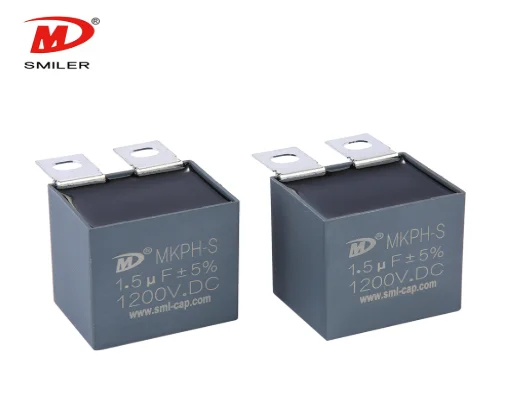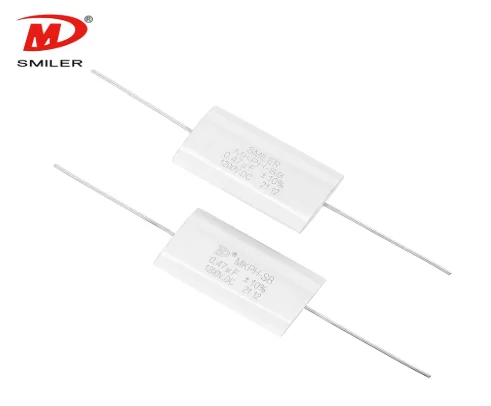
An RC snubber circuit is a useful tool commonly employed in electronic circuits to reduce voltage spikes and oscillations effectively. It comprises a resistor (denoted as R) and a capacitor (denoted as C) linked together in series near a switch or another element. The main purpose of the RC snubber lies in absorbing and releasing energy to shield components from potential harm arising from momentary voltage surges.
SMILER offers a selection of RC snubbers tailored to meet design needs. They use top-notch materials for durability and longevity, For example, SMILER’s Snubber Capacitor MKPH-S is crafted for absorbing surges in IGBT buffer circuits. It features a structure Medium made of polypropylene film, a Shell packaged in plastic and internal potting filled with resin (UL94 V-0), providing strong pulse resistance and self-healing abilities which making it perfect for applications demanding reliability.
An RCD snubber circuit is similar to the RC snubber but includes an additional diode (D) component. This diode allows the RCD snubber to efficiently redirect energy back into the power supply, reducing energy loss compared to the RC configuration. The inclusion of the diode enhances the circuit’s ability to handle higher power levels and provides improved performance in certain applications.
SMILER also offers RCD snubbers that include these design elements in their products. They have been developed to deliver top-notch performance in scenarios like switch-mode power supplies. SMILER’s RCD snubbers excel in fire resistance and self-repair capabilities to provide the safeguard for electronic components without compromising effectiveness.
The key contrast between RC and RCD snubbers is in their design and components. Both incorporate a resistor and capacitor, however the RCD snubber introduces a diode into the equation which enhances energy efficiency in high power scenarios.
Design Purpose:
Primarily used to dampen voltage spikes and reduce high-frequency oscillations in switching circuits (e.g., MOSFET/IGBT turn-off).
Key Components:
Resistor (R): Limits inrush current during capacitor charging/discharging.
Capacitor (C): Absorbs energy from voltage spikes and slows down the voltage rise time.
Operation:
The capacitor charges during the voltage spike, while the resistor dissipates energy as heat.
Simple and cost-effective but less energy-efficient due to continuous resistive losses.
Design Purpose:
Enhances RC snubber efficiency by recovering energy from voltage spikes and reducing power dissipation.
Key Components:
Resistor (R): Limits peak current through the diode.
Capacitor (C): Stores energy from voltage spikes.
Diode (D): Redirects stored energy back to the power supply or load during the next switching cycle.
Operation:
The diode allows the capacitor to discharge energy back into the system, reducing resistive losses.
More complex but improves efficiency and thermal management.
RC and RCD snubbers are widely utilized in electronic applications for reducing voltage spikes and improving circuit stability.
Low-Power Switching Circuits
Relay/Contactor Coils: Suppress voltage spikes during coil de-energization.
Small Motor Drives: Dampen voltage transients in brushed DC motors or low-power inverters.
Consumer Electronics
Switched-Mode Power Supplies (SMPS): Reduce high-frequency oscillations in flyback converters.
LED Drivers: Minimize voltage ringing in low-cost LED circuits.
Signal Integrity
High-Speed PCB Traces: Mitigate reflections and ringing in digital circuits (e.g., clock lines).
High-Power Systems
Industrial Motor Drives: Protect IGBT/SiC MOSFET modules in high-current inverters (e.g., CNC machines).
Solar/Wind Inverters: Manage voltage spikes in high-voltage DC-link circuits.
Energy-Efficient Designs
EV Chargers: Recover energy from switching transients in SiC-based bidirectional converters. SMILER offers components with minimal power dissipation for this purpose.
Uninterruptible Power Supplies (UPS): Improve efficiency in high-frequency transformer snubbing.
High-Frequency Circuits
Switch-Mode Power Supplies (SMPS): Optimize efficiency in LLC resonant converters.
RF Power Amplifiers: Reduce losses in fast-switching RF transistors.
Surges in circuits may happen between the drain and source terminals of a transistor and could cause damage if not handled correctly. These surges usually result from changes in current or voltage levels that create temporary spikes. To address this issue and protect the circuitry from harm both RC and RCD snubber circuits can be used to absorb and dissipate the surge energy effectively.

SMILER has developed solutions to tackle these issues head on with their Snubber Capacitor MKPH-LS. It is made by winding metalized polypropylene film, encapsulated with Mylar tape, and led out with tin plated copper wire, copper plug or flexible wire. It is used for absorption protection, peak voltage clamping and other applications in various inverter system switch modules (IGBT) such as inverters and frequency converters.
The presence and handling of voltage spikes can differ based on the packaging of the parts in question. Diverse packaging options may feature levels of unwanted inductance and capacitance that impact the manifestation and treatment of voltage surges, in the circuitry. For example, discreet packaging often incorporates shielding materials (e.g., conductive coatings) to block electromagnetic interference a common trigger for surges. And physically isolates sensitive components from external noise sources. Using shock-absorbent or moisture-resistant materials (e.g., silicone padding, anti-static foam) to prevent mechanical or environmental damage that could induce surges. Moreover, the heat-dissipative layers (e.g., aluminum substrates) could reduce temperature spikes linked to surge events.
A: This is used for highly inductive loads . Here the diode provides the low impedance path for the discharge current and suppress the voltage spikes . It helps to absorb and dissipate the transient energy and suppress voltage spikes by allowing transient current to bypass the diode being protected.
A: The RC Snubber finds common applications with inductive loads, such as: fans, refrigerators, air-conditioners, washing machines, tumble dryers, transformers and LED light drivers.
A: Snubber capacitors play a critical role in SiC-based power modules by suppressing voltage spikes, reducing switching losses, and protecting semiconductor devices (e.g., SiC MOSFETs/IGBTs).
A: Film snubber capacitors outperform electrolytic types in high-stress environments due to:
Longer Lifespan: No electrolyte drying, ideal for high-temperature/high-ripple-current scenarios (e.g., solar inverters, EV chargers).
Lower ESR/ESL: Efficiently absorbs high-frequency noise and reduces heat generation, critical for SiC/GaN-based systems.
Voltage Stability: Handles DC 350V–2000V with minimal derating, unlike electrolytics requiring series stacking for high voltage (prone to imbalance).
Pulse Current Capacity: Supports up to 30kA pulses, ensuring robustness in grid-tied energy storage or motor drives.